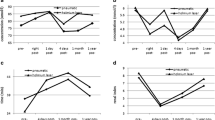Abstract
The objectives of this study were to determine the tissue effects of ultrasonic and pneumatic lithotripsy on the rat urothelium. The rats were divided into three groups. Groups I and II consisted of ten rats each that underwent intracorporeal lithotripsy (pneumatic and ultrasonic lithotripsy, respectively). Group III contained ten control rats and no lithotripsy method was used, they served as references for absence of injury. The light microscopy findings were evaluated as follows: squamous metaplasia, papillary projection, inflammation, increased stratification, and stone formation. In five (71.4%) animals of group II, bladders were edematous and hemorrhagic, macroscopically. Histologically, the bladder wall was normal in four rats of group I and in one of group II. There was a significant increase in inflammation (31.5%), squamous metaplasia (85.7%), papillary projection (71.4%), increased stratification (71.4%), and microscopic or macroscopic stone formation (85.7%) in the bladder wall of group II rats in comparison with group I and control group. In the rat model, we noted that ultrasonic devices have a potential risk for tissue injury. In turn, this was associated with a markedly increased deposition of CaOx stones in the kidney. When confronted with harder stones, pneumatic lithotripsy can be more effective while also minimizing tissue injury.


Similar content being viewed by others
References
Fernström I, Johannson B (1976) Percutaneous pyelolithotomy. A new extraction technique. Scand J Urol Nephrol 10:257–259
Lowe G, Knudsen BE (2009) Ultrasonic, pneumatic and combination intracorporeal lithotripsy for percutaneous nephrolithotomy. J Endourol 23:1663–1668
Liatsikos E, Dinlenc C, Fogarty J et al (2001) Efficiency and efficacy of different intracorporeal ultrasonic lithotripsy units on a synthetic stone model. J Endourol 15:925–928
Resorlu B, Kara C, Oguz U et al (2011) Percutaneous nephrolithotomy for complex caliceal and staghorn stones in patients with solitary kidney. Urol Res 39:171–176
Preminger GM, Assimos DG, Lingeman JE et al (2005) Chapter 1: AUA guideline on management of staghorn calculi: diagnosis and treatment recommendations. J Urol 173:1991–2000
Preminger GM, Clayman RV, Hardeman SW et al (1985) Percutaneous nephrostolithotomy vs open surgery for renal calculi: a comparative study. JAMA 254:1054–1058
Unsal A, Resorlu B, Kara C et al (2010) Safety and efficacy of percutaneous nephrolithotomy in infants, preschool age and older children with different sizes of instruments. Urology 76:247–253
Sofer M, Watterson JD, Wollin TA et al (2002) Holmium:YAG laser lithotripsy for upper urinary tract calculi in 598 patients. J Urol 167:31–34
Teh CL, Zhong P, Preminger GM (1998) Laboratory and clinical assessment of pneumatically driven intracorporeal lithotripsy. J Endourol 12:163–169
Teichman J, Vassar G, Bishoff J (1998) Holmium:YAG lithotripsy yields smaller fragments than lithoclast, pulsed dye laser, or electrohydraulic lithotripsy. J Urol 159:17–23
Lehman DS, Hruby GW, Phillips C et al (2008) Prospective randomized comparison of a combined ultrasonic and pneumatic lithotrite with a standard ultrasonic. J Endourol 22:285–289
Begun FP (1994) Modes of intracorporeal lithotripsy: Ultrasound versus electrohydraulic lithotripsy versus laser lithotripsy. Semin Urol 12:39–50
Hoffman R, Olbert P, Weber J et al (2002) Clinical experience with a new ultrasonic and LithoClast combination for percutaneous litholapaxy. BJU Int 90:16–19
Haupt G, Sabrodina N, Orlovski M et al (2001) Rapid communication endoscopic lithotripsy with a new device combining ultrasound and lithoclast. J Endourol 15:929–935
Denstedt JD, Razvi HA, Rowe E et al (1995) Investigation of the tissue effect of a new device for intracorporeal lithotripsy the Swiss Lithoclast. J Urol 153:535–537
Piergiovanni M, Desgrandchamps F, Cochand-Priollet B et al (1994) Ureteral and bladder lesions after ballistic, ultrasonic, electrohydraulic and laser lithotripsy. J Endourol 8:293–299
Xue YQ, He DL, Chen XF et al (2009) Shock wave induced kidney injury promotes calcium oxalate deposition. J Urol 182:762–765
Rabinovich YI, Esayanur M, Daosukho S et al (2006) Adhesion force between calcium oxalate monohydrate crystal and kidney epithelial cells and possible relevance for kidney stone formation. J Coll I Sci 300:131–140
Tsujihata M (2008) Mechanism of calcium oxalate renal stone formation and renal tubular cell injury. Int J Urol 15:115–120
Fuchs GJ (1988) Ultrasonic lithotripsy in the ureter. Urol Clin North Am 15:347–359
Marberger M (1983) Disintegration of renal and ureteral calculi with ultrasound. Urol Clin North Am 10:729–742
Author information
Authors and Affiliations
Corresponding author
Rights and permissions
About this article
Cite this article
Diri, A., Resorlu, B., Astarci, M. et al. Tissue effects of intracorporeal lithotripsy techniques during percutaneous nephrolithotomy: comparison of pneumatic and ultrasonic lithotripters on rat bladder. Urol Res 40, 409–413 (2012). https://doi.org/10.1007/s00240-011-0439-x
Received:
Accepted:
Published:
Issue Date:
DOI: https://doi.org/10.1007/s00240-011-0439-x




